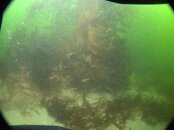I have been following this and believe the issue may come down to picture format, RAW vs. JPG. I run a TG-6 with a PT-059 housing and usually record in both RAW and JPG. I noticed a while back that the RAW files had vignetting while the JPGs did not. (The latter lends truth to Backscatter's no vignetting claim.) For comparison, the following are the same picture in RAW and JPG.
.
View attachment 667564 View attachment 667565
When I recently added the Backscatter M52 Wide Angle wet lens, the issue became more pronounced with RAW files. In the following the hood is visible. (To confirm, the lens was burped and fully screwed on.)
View attachment 667566
My reading on this topic suggests that this is a common issue across brands (Olympus, Canon, etc.). Also, the camera monitor does not show the vignetting. So as I recently discovered, one may not even be aware of the problem until at home after the dive.
So two solutions I have identified are 1) to shoot in both RAW and JPG; and/or 2) zoom in slightly to get past the vignetting. I guess cropping in a post is a third solution but I really try to frame my pictures underwater and am not smart or skilled enough to imagine trimming the edges off as I am setting up the shot.
There may well be other, better, solutions as well. I leave for Maui in a week and even though I strongly prefer to work with RAW files I will shoot in both RAW and JPG.
Please do not hesitate to let us know if you find a better solution. Best of luck!






